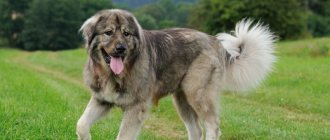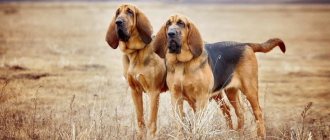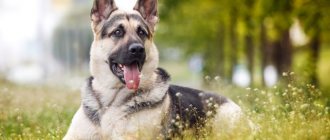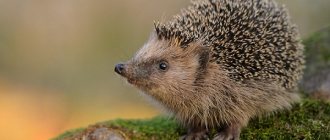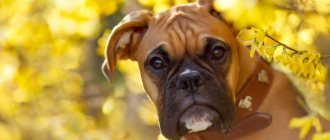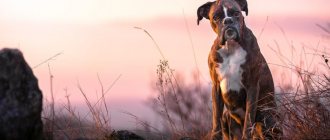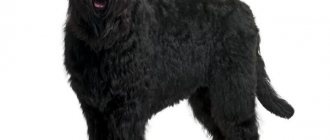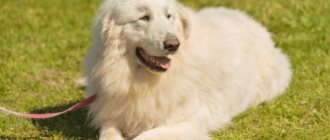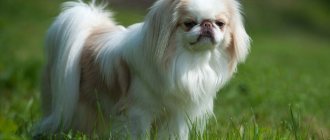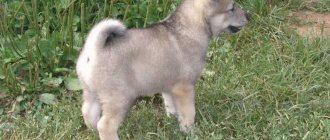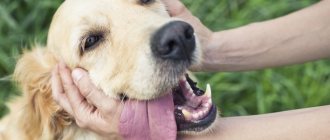The Canaan dog is an Israeli aboriginal breed that is widely used for guard and security service. Quadrupeds are little known in the world, but are widespread in their homeland and in America. Being native, the breed quickly adapts to new living conditions. According to reviews from breeders and owners, the Canaan dog excels in the role of guard, protector, shepherd and companion.
This is interesting! The Canaan dog is named after the city of Canaan, whose territory is now divided between four countries. The city took its name from Canaan, the son of Ham (brother of Noah), a survivor of the global flood and the ancestor of the African indigenous people.
There are many myths surrounding the breed, based on ignorance. The Canaan dog is an intelligent and very sensible animal. A four-legged one will play with your child for hours, but will bypass a stranger on its own. With the owner on a walk, the Canaan Dog is open to cooperation, obedient and attentive, but is wary and distrustful of strangers. Representatives of the breed are easy to train and master various specialized courses.
Care and maintenance
You can have a Bedouin Shepherd in an apartment.
But this is not the best option - due to their energy, mobility and playfulness, animals are better off living in a fenced area. You should not put a chain on your dog or keep it in an enclosure; the best solution is to freely walk around the yard. In general, the care and maintenance of the Canaan dog is similar to the care and maintenance of other guard breeds. It doesn’t matter in what conditions the dog is kept - he needs regular and long walks with high physical activity. The ideal time for this is morning and evening, the minimum walking time is 60 minutes. Due to their lack of harmony with other dogs, Canaanites (especially males) are best walked on a leash and muzzle.
The coat of pets is thick and dense, it saves them from the heat and warms them in the cold season. During periods of seasonal shedding, a lot of hair falls out, and then frequent brushing with a stiff brush is required.
The ears, eyes, and mouth of the animal are regularly examined - dirt, sulfur and foreign deposits are cleaned with a cotton pad soaked in the appropriate lotion, paw pads are lubricated with cream or disinfectant if microcracks, rashes or redness are detected.
No less attention is paid to the health of the teeth: they should be cleaned every 4-5 days with a special paste and a soft brush; if a stone is detected, you should contact a veterinarian.
A dog's claws get worn down while walking on the asphalt. Otherwise, they are cut with nail clippers once every 14-20 days.
Advantages and disadvantages
- Pros:
- excellent watchmen;
- very smart and resourceful;
- easy to educate and train;
- energetic, strong and resilient;
- love small children.
- Minuses:
- dogs are quite stubborn and have an independent disposition;
- do not get along well with other dogs, show anger and aggression;
- cannot tolerate prolonged loneliness;
- bark loudly, require frequent and regular walking with physical activity;
- are prone to genetic diseases.
Story
According to historians, herding dog breeds first appeared several thousand years ago among the nomadic tribes of Asia. In those days, they were more powerful and were able to drive away not only wolves, but even bears from the herd.
Further improvement of this group of dogs began in Europe. There they reasonably came to the conclusion that a herding dog should not only be powerful and courageous, but also beautiful, standing out against the background of a herd of livestock.
In the 20th century, new breeds of herding dogs appeared and improved. Thus, the German Shepherd was bred in Germany, and then in the USSR the East European Shepherd, more adapted to the cold climate.
History of the origin of the breed
Hungarian kuvasz has been known for a long time, its exact origin is lost in time. Based on analysis and DNA data, scientists concluded that the breed descends from the Great Dane dogs of the Tibetan Plateau. The descendants of the Tibetans came to Europe with the Tatar-Mongol hordes in the 13th century. Kuvasz was extremely popular in the 15th century Hungarian kingdom at the royal court. Dogs spread throughout Europe, accompanying herds of livestock.
In the 50s of the last century, the breed was on the verge of extinction due to extermination during the Second World War. The population was restored through the efforts of breeders. In 1905, the Hungarian Kuvasz breed standard was adopted and a complete description of the dogs was given according to the template.
The Fédération Cynologique Internationale recognized the breed in 1935. These days the breed is little known and not popular. Distributed in Hungary and neighboring countries. Kuvasz is very rare in Russia; it can be found mainly at exhibitions.
Royal dog
The first information about kuvasz appears at the very beginning of the 13th century - it was at this time that the great migration of peoples, which had lasted for several centuries, ended, and the ancient Magyars - nomads and skilled warriors - settled in the picturesque territories west of the Carpathian Mountains. Along with them came huge herds and amazing dogs, never seen here before.
Hungarians often call them royal dogs - not only for their noble disposition and aristocratic appearance. According to legend, the Kuvasz were the personal bodyguards of the famous Magyar king Matthias, whose reign (1458–1490) was replete with palace intrigues and insidious conspiracies. At Matthias’s court there lived a large flock of specially trained kuvasz who guarded their crowned idol around the clock and did not allow people who, in their opinion, were suspicious to approach him. In fact, the Hungarian king became the first owner of a Kuvasz breed nursery in history.
The Hungarian king Matthias Hunyadi can be considered the first Kuvasz breeder
But the main population of these dogs was formed, as well as their special working qualities, not in the palaces of the highest nobility, but on endless pastures, mountain and plain, in extreme conditions of service. Kuvasz dogs were first presented to the cynological community in 1863 - they made a strong impression on the audience of a large international exhibition, which served as an impetus for the popularization and further development of the breed.
Mountains and plains are the element of kuvasz
In the middle of the last century, the breed was almost lost. After World War II, enthusiasts managed to collect no more than 25 dogs throughout Hungary - and the entire modern Kuvasz population was built on their blood. They were saved not by a miracle, but by the great love and enormous work of the breeders. To this day, the National Program for the conservation and breeding of this breed operates.
Standard and purpose of Hungarian kuvasz
The native breed standard was developed, as you might guess, in Hungary. The adoption of the first standard dates back to 1954, when the breed was recognized by the International Canine Association. In the FCI breed classification, Kuvasz belong to group 1 (guard and herding dogs) and are included in the subgroup of white Hungarian herding dogs.
Appearance
Hungarians love their Kuvasz dogs so much that sometimes they even change the standard if one of the brightest representatives of the breed suddenly goes beyond it - such situations are difficult to imagine in other breeds. But the main aspects of the Hungarian kuvasz are regulated very clearly in the standard. Sexual dimorphism in these dogs is noticeably pronounced.
The FCI standard specifies all breed characteristics of Kuvasz.
Table: basic provisions of the FCI Hungarian Kuvasz standard
| Main articles | Description |
| Height |
|
| Weight |
|
| Body |
|
| Head |
|
| Paws |
|
| Tail |
|
| Wool |
|
Character and behavior of kuvasz
This big white dog is full of courage and nobility. As a representative of a glorious cohort of shepherd dogs, he is a born shepherd and an excellent guard. This is a dog of one owner, and this breed feature must be taken into account. The fact is that the kuvasz is touchingly attached to its owner - the “main owner” is for him the highest deity, no less.
Perhaps, of all the herding dogs, the Kuvasz is the most closely related to humans.
A change of owner for this dog is a catastrophe that is almost impossible to endure. Therefore, experts do not recommend purchasing dogs of this breed in adulthood, and the best age to buy a puppy is two to three months.
The owner for kuvasz is the highest deity
The Kuvasz most likely perceives small children as valuable property entrusted to its care - it tolerates their excessive activity and tries to control it as much as possible. Teenagers are treated as equals - the respect and obedience of such a dog must be earned.
Disqualities and disadvantages
The breed standard strictly guards the quality of the livestock - dogs with defects and obvious deficiencies are not allowed for breeding.
Exhibitions help select the best dogs for breeding based on conformation, but working qualities are not taken into account here.
Individuals whose height is below the lower limit cannot participate in breeding work: as well as dogs with excess body weight - heavier than 70 kilograms. The following exterior flaws are also considered disqualifying defects:
- snack (“snipe” face);
- too sharp “stop” - transition from forehead to muzzle;
- wool is hard or felt;
- tail curled or raised above the level of the rump
- kinks and creases of the tail;
- any color except white.
Canaan dog: historical data
The pariah dog is the progenitor of the Canaan dog, which is a semi-wild animal of unknown origin. Throughout their life, such canines are in close proximity to humans. It is noteworthy that pariah dogs do not retain stable external parameters from generation to generation. Since reproduction occurs without human participation, a strict culling of non-viable individuals with internal and external defects occurs in the population of pariah dogs.
If we compare a pariah dog with its Russian counterpart, it is an ordinary stray animal. The population of stray animals is endowed with a universal gene pool and at the same time a set of criteria that are specific to them. According to legend, stray dogs lived in the lands of Canaan (the ancient name of Israel). The modern Canaanite dog breed is very similar to images found in tombs at Beni Hasan, dating back to 2200-2000 BC. Archaeologists have come to the conclusion that the ancestors of the Canaan dog were revered in ancient times (photos of modern animals can be seen on the Internet). This conclusion follows from excavations of a dog cemetery in Ashkelon, where about 700 animals were buried, the skeletons of which are very similar to modern representatives.
The Canaan Dog appeared thanks to the painstaking work of Dr. Rudolfina Menzel. The Haganah (Palestinian underground organization) asked the doctor to create attack dogs to fight the war of independence. Dr. Menzel remembered the pariah dogs that lived in the harsh climatic conditions of their homeland, and selected several individuals that served as “material” for the creation of the Canaan dog (see photo).
The result of the work was the Canaan dog breed, characterized by a high level of intelligence and speed of learning. Representatives of the breed were sentries, messengers and assistants of the Red Cross, and search dogs for detecting landmines. When World War II began, Dr. Menzel selected 400 of the best specimens for the Middle East forces.
In 1948, about 150 Canaan dogs were registered in the stud book. The breed was first recognized in Palestine and then in Israel. In 1965, Mrs. Ursula Berkovets brought 4 representatives of this breed to California for breeding in the United States. In 1996, the Board of Directors of the American Kennel Club decided to add the Canaan Dog to the AKC registry. Since then, the Californian club has been considered the “progenitor club” of the breed. In 1997, the Canaan dog breed received the opportunity to participate in exhibitions due to its inclusion in the classification of herding dog breeds.
Video
https://www.youtube.com/embed/
* We invite you to watch a video about the Bully Cutta breed. In fact, in front of you is a playlist in which you can select and watch any of 20 videos about a given dog breed by simply clicking on the button in the upper right corner of the window. In addition, the material contains quite a lot of photos. By looking at them you can find out what Bulli kutta looks like.
The Bully Cutta is an exceptionally large and strong dog, very similar in appearance to a Great Dane or Mastiff. This is an ancient indigenous breed of India and Pakistan, bred to guard property, protect the owner and bait large animals. In the modern world, it has become a popular fighting breed in countries where this brutal entertainment has been preserved. Quite rare outside the homeland, not officially registered and recognized only by its fans.
| Material content: |
Vaccination
In general, the vaccination schedule is similar to that applicable to other breeds:
- For rabies, the first injection is given at 12 weeks, then repeated a year, carried out annually.
- They are vaccinated against plague at 8 weeks, revaccinated every year, and repeated every year.
- For parainfluenza, an injection is given at 8 weeks, then repeated a year, like every subsequent year of the dog.
- Protect against enteritis at 10 weeks, re-introduce a year, repeat annually.
- Protect against leptospirosis at 10 weeks, repeat at 12 months, then annually.
- The microsporia vaccination is given at 28 weeks, then repeated annually and annually.
- The vaccine against trichophytosis is given at 28 weeks, a year and annually.
Best articles: Pussy-Cat litter tray: manufacturer, properties, reviews
Who should start
Connoisseurs of the breed categorically do not recommend it to beginners: the stubborn nature of this dog can infuriate even a saint, and in addition, you need to find an approach to it. To do this, you will have to be a firm and understanding owner at the same time. You need to devote a lot of time to this dog, work with it, give it work.
They treat children as their wards, protecting them with all love. And yet, a dog remains an animal with deep instincts, so teach your child how to behave with a pet: the child should not distract the dog while eating, unexpectedly pull its tail or ears, or try to cause pain.
Canaanians live well with cats, but they show aggression with dogs of the same sex. You should not get this breed if you have rabbits, hamsters, ferrets, etc.
Key facts
Canaan dogs are amazing and unusual creatures. They can easily tolerate heat and are able to work under the sun for a long time. There is an opinion in the animal kingdom that these are the only dogs that carry out commands in Hebrew - of course, this is just a joke.
Canaan dogs are incredibly loyal and selfless. According to ancient legend, animals were the favorites of Queen Jezebel, they accompanied her everywhere and guarded her near the throne.
During wars, Canaan dogs were used as assistants, messengers, and in detecting mines. These days, dogs serve in rescue and security organizations and become favorites and companions for many families.
Description of the Canaan dog breed combines:
- flexible and peaceful disposition;
- good mental abilities;
- strength, strength, endurance;
- cheerfulness, playfulness;
- developed guard instinct;
- excellent training abilities.
Experienced owners do not recommend having Canaan dogs for constantly busy or weak-willed people. Animals require a special approach and are ready to submit only to the leading breeder. Canaanites do not tolerate prolonged loneliness well; moreover, due to their activity and energy, they need long walks with increased physical activity.
The Canaanites treat small children with special care, consider them their “wards”, and protect them with affection and love. But at the same time, the child must treat the dog with respect - it is unacceptable to hurt him, pull his ears and tail, or take away his favorite toys and food.
The Bedouin Shepherd gets along easily with cats, but shows aggression towards other dogs. There are problems if there are ferrets, rabbits, hamsters and other small animals in the house - the dog’s hunting instinct is highly likely to be triggered.
Characteristics of the Canaan dog breed include many interesting facts:
- The breed was obtained in Israel by crossing stray semi-wild dogs of the Middle East and North Africa.
- The dogs are devoted to the breeder, gentle and caring with small children, not cowardly, vigilant, and are wonderful watchdogs. They easily get used to new living conditions and are easy to train.
- With proper maintenance and proper nutrition, the life expectancy of Canaan dogs is 12-15 years, but their health must be carefully monitored.
- Minimal grooming is required, since Canaanians are very clean; they only need regular combing of their fur during the molting period.
Good physical shape can be maintained through increased physical activity and active games that require endurance and dexterity - both from the dog itself and from its owner. Canaan dogs require systematic training, but they do not like repeated repetitions of the same exercises and may refuse to do them.
Features of proper care
In order to raise a truly proper hunter, you must have certain skills in such education. Therefore, if you do not have this experience, then it is better to seek help from professionals. Only a specially trained person will be able to direct all the energy and activity of the animal in the right direction.
As for the main content, the best conditions are a country courtyard estate, a flattened enclosure and a warm booth. Only under such living conditions will the dog be active, healthy and develop properly. Adequate space is exactly what this breed needs.
During the walking process, you need to be very vigilant, because if you let the dog off the leash, then, due to its basic instinct, it can take some kind of trail, which can, in some cases, end in tears for smaller individuals. Therefore, it is better to walk Foxes in a deserted area, where there are a minimum of foreign animals.
If we talk about basic animal care, then your pet practically does not need anything supernatural. It is worth bathing your pet periodically and monitoring its coat.
Food should include all the necessary vitamins and microelements that are necessary for the normal growth and development of the foxhund. The owner can give preference to both specialized feed and natural products.
Choosing a nursery and price of pets
Since the animal has a stubborn character, and the price of a healthy microclimate and friendly relations between the owner and the pet is the patience of the owner, such a dog should not be chosen by those who do not have such a character trait. In our country, the Canaan dog is a little-known breed, so its price is about 150-350 dollars.
There are no nurseries engaged in breeding this particular breed in Ukraine and Russia. However, in Poland there is a kennel “Nugget of Canaan”, which works closely with different countries and offers its puppies. All issues regarding the delivery of the puppy and documents are resolved by representatives of the nursery. On the nursery's website you can see numerous photos of animals.
From well-known breeders the price of the breed reaches 750-1000 dollars. If you buy it secondhand or at a poultry market, then there is a high probability of purchasing an ordinary mongrel with a suitable appearance.
Conditions and care
Generally speaking, keeping Canaan dogs in an apartment in an urban environment is allowed, but not recommended. A more optimal option would be to live on a private plot of land.
However, even in this case, it is important to take into account that the Canaan dog should not be kept on a leash or in an enclosure; he must be provided with the opportunity to walk freely throughout the territory
Even if the animal lives in a private house and is constantly on the street, walks outside the territory of the house will not be superfluous. However, remember that dogs must be walked on a leash, otherwise the dog may get involved in dangerous fights.
The Canaan variety is characterized by a shedding process, so it is important not to forget to regularly comb the hair using special brushes and pay special attention to hair care
As for hygiene procedures, mandatory processes in this regard include examination of the nose, mouth, ears and paw pads
It is important to make sure that no part of the animal’s body has scratches, damage, irritation or rashes (if any defects are found, you should immediately consult a doctor)
Another mandatory procedure is brushing your teeth. It is recommended to carry it out at least once every 3 days. To do this, use special cleaning products designed for dogs.
Nutrition
Canaanians are unpretentious eaters. You can feed them dry food or cook your own food. However, breeders strongly advise creating a diet based only on natural food. Their menu should consist of 70% protein. The list of recommended products is quite large:
- meat (poultry, beef);
- offal;
- eggs;
- fish (boneless);
- cottage cheese;
- a moderate amount of cereals (buckwheat or millet);
- fruits (infrequently) - pears, apples, bananas;
- vegetables (pumpkin or carrots).
Features of feeding and diet
Natural products must be present in the daily diet of a Palestinian dog:
- Raw meat.
- Chicken eggs - no more than 2 times every 7 days.
- Ryazhenka, kefir and yogurt - every 5 days.
- Cereal porridges made from rice, buckwheat, corn, oatmeal.
- Boiled or raw vegetables that can be mixed with meat.
- Vegetable oil, add 2-3 tablespoons to any food.
Spicy, smoked, salty foods, beans, potatoes, sweets and flour products are completely excluded from the dog’s diet. They provoke indigestion or allergies.
If you prefer dry food, it should be premium with natural meat. Portions should be rationed according to the daily allowance for the specific age and weight of the pet.
It is important to ensure your dog has constant access to fresh water. After eating, she needs to be given some time to rest so that the food is well absorbed.
Diseases of the Canaan Dog
The average life expectancy of a representative of the breed is 12–15 years. There are no specific genetic diseases identified for Canaanians; the dogs are positioned as strong and healthy. However, there are a number of problems that representatives encounter most often:
- insufficiency of thyroid function, or hypothyroidism, which most often manifests itself as metabolic disorders and obesity. The typical age for symptoms to appear is 3–4 years, and the problem is more common in females. The disease requires constant hormonal therapy;
- ophthalmological diseases, in particular retinal atrophy, which has a genetic predisposition. This disease begins its development from the first days of a dog’s life and leads to loss of vision. It cannot be cured;
- hip dysplasia, which is also inherited from parents. To make sure there is no problem, you can undergo an examination at a clinic, where doctors will give a clear answer about the condition of the puppy’s pelvis and the risk of developing a disorder. You can notice something is wrong almost immediately - the dog begins to walk worse, the function of the hind limbs is impaired, and activity decreases. There is only one treatment in this situation - surgery to correct the shape of the head of the bone.
How much does it cost and where can I buy it?
Today there are just over 1,600 Canaan dogs in the world, so you will have to wait in line for a puppy. Be sure to look at the mother of the future pet, evaluate her social skills - in 90% of cases, the puppy inherits these qualities from the mother.
There is no nursery in Russia that deals with this breed. Only 7 representatives of the breed live in Moscow and the Moscow region. If possible, you can contact Israeli breeders. One of the Polish nurseries is actively working with Russia.
Puppy price: from $700.
A puppy that has certificates of freedom from diseases costs from $1000.
The Polish nursery offers to buy puppies from 80,000 rubles.
Purchasing a puppy
Canaanites are widespread only in their homeland - Israel. There is some popularity in the USA and Europe. Purchasing a puppy is complicated precisely because of the rarity of the breed.
There are no nurseries in Russia and the CIS countries; only one breeder from Poland delivers puppies to these countries. Another option is to purchase the baby in his historical homeland.
The average price for Canaan breed puppies varies and averages 30-40 thousand rubles (1 thousand dollars). In a Polish nursery, puppies are offered for 80 thousand rubles.
Before choosing a pet, you need to familiarize yourself with the pedigrees of the parent dogs and find out the presence of genetic predispositions to diseases. This way, the future owner will be aware of possible health problems in the baby. The issue of feeding the pet is also discussed with the breeder. Depending on the general condition and future living conditions, the dog can be given an individual diet.
In order not to get caught by scammers, you must first study not only the breed itself, but also information about all available nurseries. It is possible to distinguish a Canaan dog from a mixed breed from a photo by reading its standard.
Hovawart care
In general, the Hovawart is suitable for keeping in an apartment, but it needs a lot of space to move. Here, at least, the dog’s protective instinct can be realized, because there is a specific owner’s territory that can be walked around. In such conditions, the Hovawart will need to be walked for many hours every day, so that walks will literally bring him to exhaustion. Of course, it is difficult for the average owner to fulfill this requirement.
In this regard, an enclosure will also not satisfy the dog’s needs, even if you walk it for at least 2 hours in the open air. The Hovawart is absolutely not suitable for keeping on a chain. Here, not only physical activity will suffer, but also the animal’s psyche.
The dog is ideal for a private yard, where it will fully demonstrate its breed's protective qualities, having room for free movement and constant walking around the entrusted territory. But the owner must provide this territory with a high fence: the Hovawart jumps well and quickly attacks the intruder without waiting for the owner’s command.
A private yard with a high fence is an ideal place to keep a Hovawart.
Wool
At first glance at the long wavy coat of the Hovawart, it seems that it is precisely this that requires constant care. But that's not true. The dog's fur has water-repellent properties and practically does not get dirty. Therefore, Hovawarts are bathed 3-4 times a year, or as they become dirty, if the fur begins to give off an unpleasant odor.
Top articles: How to measure distance on a map using a degree grid?
But you need to comb your pet 1-2 times a week to prevent the formation of tangles. During the molting period, this procedure is performed daily.
Claws, ears and teeth
Unlike fur, claws, ears and teeth require more attention from the Hovawart owner.
The dog’s teeth are brushed, like other breeds, once every 7–10 days. To do this, use a special brush and paste.
A working dog does not need to trim its nails; they wear down naturally. They are only regularly inspected for chips and cracks. For domestic (and even more so for exhibition) specimens, the procedure is carried out once every 2 weeks. It is better to accustom the Hovawart to trimming its claws from puppyhood, then the procedure will be accepted by the pet calmly.
Once every 2 weeks, the pet’s ears are also cleaned. They are also checked for parasites. Thus, an unpleasant odor or discharge should prompt you to consult a veterinarian.
Nutrition
The young Hovawart dog is growing at a rapid pace. In addition, dogs of this breed are generally very active, therefore, nutrition should provide them with building material for muscles and bones, and the necessary energy.
Breeders recommend feeding Hovawarts with dry food. It should be at least premium class, ideally super premium or holistic. Such nutrition will provide all the body's needs; additional vitamin and mineral supplements are not required.
Hovawarts do not have a breed tendency to allergies or digestive disorders, so the owner can choose food depending on the pet’s own capabilities and preferences. But dogs of this breed are food lovers, so the owner should strictly follow the recommendations of the food manufacturers.
The following are suitable for feeding the Hovawart:
- Acana;
- Almo Nature Holistic Adult Dog Large;
- Barking Heads;
- Orijen;
- Pronature Original.
With natural nutrition, the owner will have to balance the diet himself and add vitamin and mineral components to it. Here it is better to consult a veterinarian.
In general, feeding Hovawarts does not differ from the diet of dogs of other large breeds:
- The basis of the menu should be lean meat (2/3 of the diet), the rest (1/3) should be plant foods.
- The meat must first be frozen. The fish is cleaned of bones.
- Fruits and vegetables are finely chopped, after removing tops and seeds. They can be given raw or cooked (stewed).
Not suitable for feeding:
- cabbage, potatoes, legumes;
- fatty meat or fish;
- sweets, confectionery, chocolate;
- food with added salt and spices, spicy and smoked.
Like other dogs, the Hovawart needs clean, free access to water. Breeders even recommend taking water with you on walks so that an active dog can satisfy its thirst.
Basic moments
- The South Russian Shepherd is a rare, almost exclusive breed, the development of which has been negatively affected by commercial breeding observed in recent years.
- Yuzhaka wool produces excellent yarn, from which you can knit or felt beautiful things that have a healing effect.
- In the case of JRO, differentiation on the breeding line is almost never practiced, so the choice of a future service dog and a companion dog has to be done within the same litter.
- One of the favorite pastimes of South Russian Shepherd dogs is digging holes, which, given the size of the breed, are more reminiscent of construction pits.
- Yuzhaks are not recommended for keeping as a first dog, or for people who do not have experience in training working shepherd dogs.
- You will have to take a lot of care for the fur of a show-class pet, and not without the help of groomers. Keep in mind that the fluffy “fur coats” of Yuro quickly fall off, attract small debris and easily change color depending on the diet.
- Paradoxically, although they are not essentially bullies, South Russian Shepherds do not establish contacts well with other dogs and are able to make friends with few of their fellow tribesmen.
The South Russian Shepherd Dog is a shaggy heroine who has established herself as a professional guardian of the owner's peace and well-being. Possessing a serious character and innate suspicion of violators of territorial borders, the Southerners never stir up conflicts from scratch. The only thing you have to take into account when having a South Russian Shepherd at home is the breed’s tendency to be proactive and think for the owner in critical situations.
Character and training
The character of the Canaan Dog is surrounded by a lot of speculation, which is not surprising, since not many people can judge the breed from experience. In accordance with the breed standard, four-legged dogs are alert, attentive, easy to train and very loyal to their owners. Observations in the natural environment have made it possible to establish that four-legged animals are often guided by intuition and are able to make lightning-fast decisions.
Interestingly, the native Canaan dog is very attached to the owner, family and especially to children. For younger family members, a four-legged friend, companion, nanny, and protector. In relation to strangers, the Canaan Dog is distrustful, wary, but restrained to the last. There is a myth that representatives of the breed are aggressive, but in fact this is not the case. Even semi-wild representatives are very sociable and love the company of people and their relatives. Males can fight, but only for the heart of a lady, or rather, for the right to mate. Aggression towards people, and especially towards children, was eradicated from dogs in an absolutely inhumane, but most reliable way - all individuals with an unyielding character were either not allowed near the settlements or were destroyed.
The Canaan dog is naturally territorial and has a bad attitude towards newly arrived competitors, but with the right approach, the four-legged dogs get along with both cats and dogs. It is an undeniable fact that representatives of the breed tend to chase cats and other animals on the street, especially if the dog regularly walks in the same territory (considers the territory to be its own).
From early childhood you need to socialize your pet. We are not talking about enhanced measures, but the dog must distinguish a stranger from its own. You should not expect the Canaan Dog to be friendly or openly friendly towards strangers and dogs, at least until your four-legged dog gets used to the new environment. Judging by the reviews of the owners, already on 2-3 walks in a new company, the Canaan Dog happily plays with his relatives and greets their owners.
Representatives of the breed are highly trained and easily master training courses of any complexity. After training, the four-legged animals obey commands without any problems, always hear the owner and are happy to learn new skills.
Behavior and temperament
This breed has a developed pack sense , and in this pack it is you who must take the place of leader. They have a strong will, but also endless devotion, they completely devote themselves to their family . They are distrustful of strangers and do not show feelings even towards those people who are often in the house.
Don't believe anyone who tells you that the Canaanites are cowardly. The fact that they shy away from strangers indicates their distrust , but if they feel threatened, they will immediately respond with dignity to the offender.
Since they have been guarding people for a long time and were watchmen, they bark when they hear a suspicious sound or a knock on the door.
They are smart, but prefer to be cunning and hide this advantage, especially if the owner allows them to be lazy and does not punish them for ignoring commands. At the same time, they love to work , and if they do not find a suitable occupation for themselves, then they dig holes with pleasure.
Important: Canaan dogs between 9 and 12 months of age may begin a period of fear that lasts until they are two years old. At this time, they behave restlessly, barking at objects that do not pose a threat.
The owner’s task: to give the puppy self-confidence, to prove to him that everything is fine. You yourself must be calm and convincing. Sensing your mood, the dog will calm down.
This dog needs human company and greatly appreciates his attention. Give her more time so that she has a stable psyche.
Choosing a Pumi Puppy
Where to start looking for a puppy,
Of course, from visiting specialized exhibitions. Here you can get to know the best representatives of the breed, communicate with their breeders, and decide on the most interesting breed lines and nurseries. If you are planning a show career, but do not have enough experience to choose a high-quality dog, invite an experienced expert to the kennel. It is also useful to listen to the recommendations of your breeder, because he, like no one else, knows all the advantages and disadvantages of his dogs. The most important factor influencing both the exterior and the psyche of a puppy is heredity. Therefore, be sure to meet the parents of the future pet (this can be done in advance or when visiting the nursery). You should not only evaluate the appearance of the dogs, but also their physical and mental health. Regardless of whether you choose a dog based on the requirements of the standard, or are guided solely by the call of your heart, examine the puppy for health. The dog should have a soft belly, clear skin, eyes and ears, and a shiny, cool nose.
It would be useful to remind you that perfect cleanliness should reign in the nursery
Experts advise paying special attention to the character of the future pet. Of course, this is largely a matter of personal preference, but professional breeders recommend choosing the most energetic, playful, courageous dogs without signs of aggression
Pungsan mating
In principle, the female is ready to meet a male and for her first heat, but you can’t breed so early! The ideal days for mating are considered to be from 11 to 15 from the start of estrus.
It is best to breed a female by the age of 2, just like males. Under no circumstances should males be bred before two years of age. Early sexual activity will not improve the health of either the dog or the offspring.
- Before mating, animals need to be given a good walk, but should not be fed. It is better to introduce dogs on neutral territory so that they can get to know each other and run around, and then lead them to the male dog’s territory.
- Matings should always be carried out only in the territory of the dog. Actually, an act of love can also happen during dating, so don’t interfere with the process.
So, you're in male territory. Most likely, no intervention will be required, and the bitch, having played enough with the male, will allow a persistent suitor to mount.
If one of the partners for mating is small in relation to the other, then you can place a pillow under the hind legs or, if the bitch is shorter, place her belly on a bent knee. This advice is more relevant for small breeds. Just don’t try to bend the bitch’s paws so that the dog can reach her.
After ejaculation, mating occurs. The male can be on the bitch or stand with his back to her. The animals will figure it out on their own. However, if the lady tries to break free or lie down, do not allow her, hold her back a little. Also try not to scare the dogs.
It happens that after mating, mating does not occur and the male immediately loses interest in the female.
Be sure to carry out a control mating after 24-48 hours.
Training and education
You need to start raising and training your dog as soon as it crosses the threshold of your home. You should immediately accustom the puppy to its name, collar and leash. And also make it clear which of you is in charge. When keeping a pet in an apartment, teach the puppy to relieve itself outside.
Spanish Alanos are attentive and quick-witted. Despite the intelligence and obedience of Alano dogs, we should not forget that, first of all, this is a dominant, fighting breed, and it is better not for an amateur in dog breeding to train it. It is recommended that you take your pet through a professional training course under the guidance of an experienced dog handler.
If you still decide to train Alano yourself, then you need to take into account that, firstly, you must be an undeniable authority for the dog. Secondly, any use of force risks the dog becoming an aggressive and uncontrollable dog, which will be dangerous not only to others, but also to you and your family.
Nicknames for Shih Tzu
When choosing a nickname for a pet, you can take into account its noble origin (after all, the ancestors of the mini Shih Tzu lived in imperial palaces and delighted the eyes of the top officials of the Celestial Empire).
Or you can focus on the baby’s cute appearance and positive character. Therefore, names for Shih Tzu boys can be proud, for example, Archibald, Dominic, Caruso, Truffle, Churchill. Or infinitely cute: Bonnie, Georges, Leaf, Mickey, Sunny, Tim. If you want to name your pet in the Russian style, the names Venya, Raisin, Krosha, Kuzya, Styopa, Tema, Funtik, Yasha are suitable.
Names for Shih Tzu girls can also be stylish: Vanessa, Gabby, Bianca, Juliet, Jasmine, Lady, Matilda, Olivia - the names of both fairy-tale princesses and popular actresses are suitable for them. By the way, there will also be touching nicknames: Didi, Klepa, Lyalya, Mika, Simka, Fairy. And among the Russian “names” the nicknames Asya, Businka, Vanilka, Zhuzha, Munya, Sonya, Tykovka, Yusechka go well with the breed.
Popular colors of Bully Cutts
The colors of the breed are not strictly regulated, but a certain set of colors has developed historically and is most common. It should be noted that, regardless of color, Pakistani Mastiffs should have dark eyes and a black nose at the darkened end of the muzzle.
Best articles: TOP 10 basic facts about the cells of living organisms
The variety of colors is not very wide; dog skins can be:
- Solid colors (usual colors: black, white, fawn, brown), with colored individuals usually having white paws and often a white chest and belly. On a white background, speckling is possible;
- Brindle: black stripes on a fawn or brown background. The ratio of colors and the width of the stripes can vary and the color changes accordingly from reddish with sparse thin shading to almost black with rare stripes of red color;
- Bicolor, combining a white background with large spots of black or fawn;
- Harlequin - small dark spots on a light background, often combined with bicolor colors.
It is unknown what the ancient, original phenotype was that existed before colonization by the British. Many sources indicate that it was pure white, sometimes with colored (black, fawn) spots on the back (bicolor) or with gray speckling on the muzzle and groin. However, the Sindhi variety, which is considered to be very ancient, is fawn in color with a white chest and spotted feet.
White dogs are indeed very popular in Pakistan, and they are often pure white and even without markings. But the reason may be that white color is considered very beautiful and noble among Muslims; the selection of white individuals may simply be a tribute to this belief.
Characteristics
The Canaan dog in the photo looks good-natured and friendly. The International Canine Association classifies this dog breed as a Spitz. This is a simple, slightly “knocked down” exterior - a medium-sized dog, a laconic silhouette, everything in the appearance of the breed speaks of its simplicity and practicality. Some features of its appearance make this dog close to wolves.
For example, a large proportional head with an elongated muzzle. At the same time, the dog’s forehead is flat, its eyes are large and clear. The jaw is well developed, which makes the dog’s grip strong and unbreakable. The teeth are white, long, but not large, the bite is regular or scissor.
The nose is always black, regardless of the color of the individual. The eyes are almond-shaped and the eyebrows are movable, making the look expressive. Eye color is brown, with darker or lighter shades.
Whatever the color of the Canaan dog, the nose should always be black
The ears are triangular, erect, large to capture maximum sounds, and set wide. The tip is slightly rounded. Inside, they are well protected by short hair, which protects against sand and debris.
The neck is short and dense, mobile. The muscles are well developed, so it is easy to feel under the fur and through the thin skin. The body is square-shaped, the back is straight and short. The paws of such a dog, although long, are still not suitable for racing. But the dog is prone to jumping, its hind legs are more developed than its front legs.
Strong short fingers and long claws make the breed capable of digging deep holes. The tail is fluffy, thin, and quite long. The Canaan dog moves smoothly, gracefully, mostly at a jog. Height is from 52 to 62 cm, depending on gender - males are taller and larger than females. Weight, respectively, from 22 to 26 kg.
Diseases of the Canaan Dog
The average life expectancy of a representative of the breed is 12–15 years. There are no specific genetic diseases identified for Canaanians; the dogs are positioned as strong and healthy. However, there are a number of problems that representatives encounter most often:
- insufficiency of thyroid function, or hypothyroidism, which most often manifests itself as metabolic disorders and obesity. The typical age for symptoms to appear is 3–4 years, and the problem is more common in females. The disease requires constant hormonal therapy;
- ophthalmological diseases, in particular retinal atrophy, which has a genetic predisposition. This disease begins its development from the first days of a dog’s life and leads to loss of vision. It cannot be cured;
- hip dysplasia, which is also inherited from parents. To make sure there is no problem, you can undergo an examination at a clinic, where doctors will give a clear answer about the condition of the puppy’s pelvis and the risk of developing a disorder. You can notice something is wrong almost immediately - the dog begins to walk worse, the function of the hind limbs is impaired, and activity decreases. There is only one treatment in this situation - surgery to correct the shape of the head of the bone.
Health and life expectancy
Canaan dogs tend to be in good health. With good care and nutrition, they rarely get sick. The average life expectancy is 13-15 years.
The introduction of semi-wild dogs into breeding allows us to expand the gene pool and keep the breed healthy. But not every dog caught is a Canaanite, only one living in a certain area of the desert. In addition, it must meet the standard and be tested for health. Like ordinary dogs, Canaan dogs are usually vaccinated and regularly treated against external and internal parasites.
Character of a sled dog
Chinook is a great friend, because it is characterized by:
devotion, fidelity. These dogs are famous for their special sensitivity and love towards their owner, so in the person of a Chinook a person will gain a friend for life;
- high level of intelligence. The breed was created to work in the difficult conditions of the North; for this, the animal needs to be able to navigate, analyze the situation and make the right decisions along the way. In snowstorms and impenetrable darkness, man was powerless, and only sled dogs ensured his survival;
- calmness. The influence of northern latitudes is also felt in the cold, reasonable temperament of the Chinook. Aggression is alien to him, he shows it only as a defense, and can also get nervous when the situation changes;
- kindness and friendliness. This wonderful dog will find a common language with both children and pets, including other dogs. He does not tolerate loneliness well, he may even get sick because of it;
- silence. The Chinook is not a good watchman; this breed rarely barks. But one should not consider him a coward. Such a dog is able to fight back any threat that hangs over him or his owner. Bravery, coupled with considerable size, most often ensures victory for the Chinook over the enemy;
- activity and performance. This dog was originally supposed to race through the snow for hours with a load on its back. And although today the need for this has disappeared, the energy reserve remains.
Personality
They love to learn, they love to be at one with a person and do the same thing, they are very hardy and generally love work, no matter what it is.
They treat strangers with caution, but without aggression. These dogs love children very much and can be excellent nannies, although if the child is very small, you need to take into account that with one careless movement the Chinook, simply because of its size, can knock the child down
This breed strives to please the owner, but without stupid groveling, rather, they like to feel like they are part of a team. Therefore, there are no problems in training with them - they are very versatile. If you, for example, need a guard dog, you can quite achieve this. Like other dogs, they should not be chained, as this will have an extremely negative impact on their psyche.
The Chinook has a high energy level and needs regular walks and a variety of activities. He adapts perfectly to different living conditions; he can live in a city apartment, but will feel best in a private house with a spacious yard. To summarize, we can say that he is a big, smart, kind-hearted dog who is always happy to help his owner and will never offend his family.
Which owner is it suitable for?
The first requirement for a future Chinook owner is to have time for the pet. Every dog needs attention, but such a dog will become another member of the family. Moreover, an active member. He will need training, regular training, long runs in the fresh air, fun games to use up his huge energy reserves. And the owner should be prepared for this.
Chinook is a pack breed. Such a dog must have a leader, otherwise the dog will decide that he is the leader. In this case, you will not envy the owner. To control such a beast, you need to have a strong character and will. These traits will be especially useful during the learning process.
Owner reviews
The owners rate this dog positively . The external beauty of the animal is noted. I like their deep and kind look. Indeed, the dog is very hardy, active, healthy. This is a clean beast. One of the main advantages of the Canaan dog is its loyalty. This is a great friend and companion. Unpretentious in maintenance, he is ready to give his life for the owner and his family. Almost an ideal family dog. He loves children and all family members madly.
Return to content
Appearance
The Canaan dog is a robust, medium-sized dog with a lean, balanced, square build. In general, it retains the wild type, which is also characteristic of the dingo or Carolina dog. Sexual dimorphism is very well expressed. Height at withers - 50-60 cm, weight - 18-25 kg.
The head is of correct proportion, medium length, blunt wedge shape, the skull is somewhat flattened. The stop is noticeable, but not sharp. The muzzle is of moderate width and length, strong. The nose is black, the eyes are dark brown, almond-shaped, slightly slanted. Eyelids dark. The lips fit tightly. The jaws are strong. The bite is straight or scissor. The dental formula is complete. The ears are set low, erect, wide at the base and relatively short, slightly rounded at the ends.
The neck is of medium length, muscular. The body is square, the withers are well defined, the back is straight. The loin is muscular. The chest is of moderate width, deep, and the ribs are fairly curved. The belly is well chosen. The tail is carried curled over the back, set high, and well covered. Limbs are balanced, with moderate angulations. The paws are round, strong with durable pads. The dog's movement must demonstrate endurance and agility.
Double coat. The outer hair is coarse, dense, straight, short or medium length. The undercoat lies close to the body and is abundant. Color ranges from sandy to reddish brown, black, white or spotted. With or without a mask. Black and tan, tricolor, brindle or gray colors are not acceptable.
Alabai - description of the breed
Central Asian Shepherds have a perfectly balanced body with fairly muscular and high withers. The back of animals is straight, short, but strong, and the lower back is convex. The Alabai's croup is wide, with well-developed muscles. Shepherds have a short neck, but muscular and powerful.
The breed is characterized by low, small ears. Ears are not cropped in all countries - it all depends on the approved norms and standards for a given breed. Powerful and massive jaws, on which the incisors are located like a guillotine, provide a death grip. The lower jaw is completely covered with fleshy lips. Single broken incisors do not affect the animal's bite. Alabais have a large, symmetrical head with a blunt muzzle that does not taper towards the nose. Skull with occipital protuberance, flattened.
Asians have fairly well-developed intelligence. The mental abilities of shepherd dogs are rated by dog handlers as four points out of a possible five. Dogs are characterized by a stable nervous and mental state. They never show aggression without a reason. Before an attack they always warn with a threatening roar. If there is no reaction, then when provoked they attack with lightning speed.
Asians are distinguished by their touchiness, they have a pronounced sense of self-esteem. You must show respect to them and then they will respond with loyalty. The educational process should begin as early as possible, since the character is formed already at the tender age of puppyhood. With proper care, Alabai live quite a long time: from 10 to 15 years.
According to the standards, the indicators of sexually mature shepherd dogs are as follows:
- The height of a male is about 70 cm, that of a female is at least 65 cm;
- The minimum weight of an adult is 50 and 40 kg, respectively.
